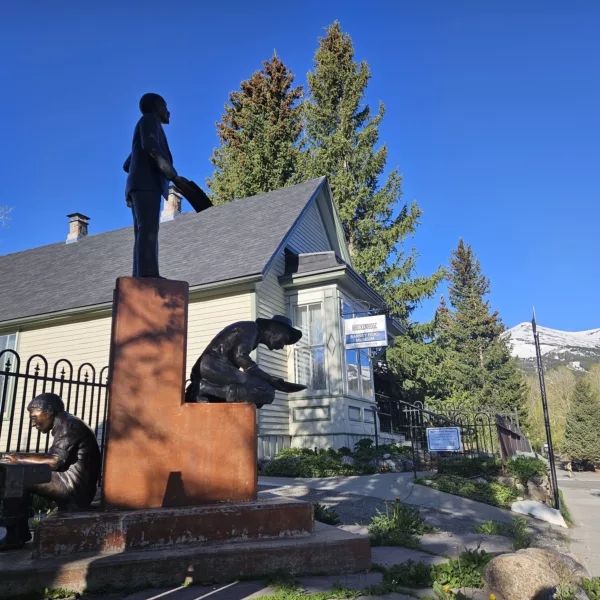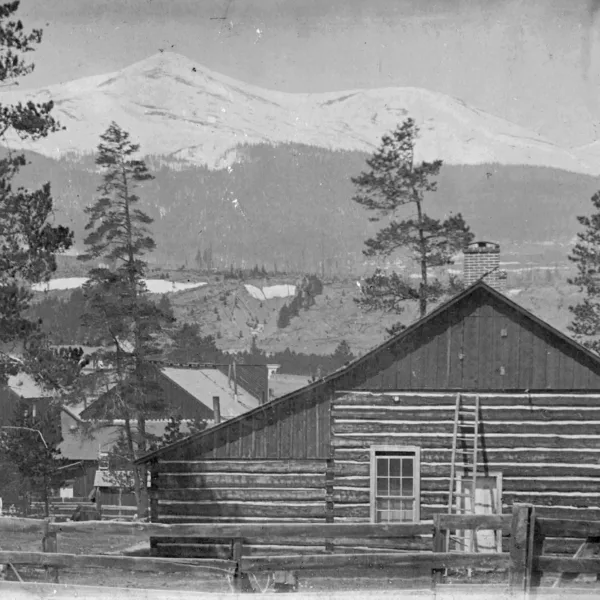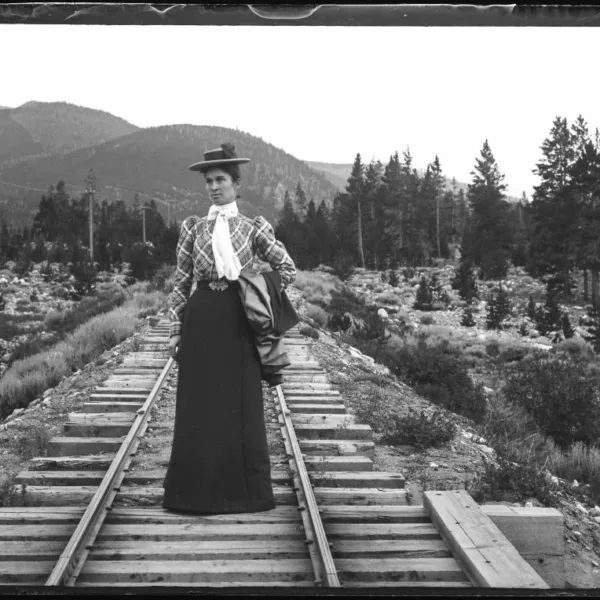The Mysteries of Fort Mary B.
March 23, 2023 | Category: Our Collective History
The community of Breckenridge began in 1859-60 as a collection of rustic log cabins and a protective fort when a group of hearty prospectors and one woman over-wintered along the Blue River. The fort became known as Fort Mary B. in honor of that intrepid female. Who was Mary B. and where was the fort located? Follow Breckenridge History as we explore the earliest days of Breckenridge town and the mysteries of Fort Mary B.
August 10, 1859, marks the start of Breckenridge as we know it today. Prospectors birthed a community along with their gold discoveries. Searchers found gold in the Blue River by spring of 1859, but it wasn’t until that August day, when Ruben J. Spaulding found enough gold in his pan to stake a claim, that settlement began. Spaulding’s discovery prompted the formation of the first mining district along the Blue River. With a mining district in place, the community began its growth that continues today, over 160 years later
Needing a governing structure for the development of their mining district, the prospectors established the Spaulding District and wrote the “Journal of Procedeings In and for the Spaulding Diggings.”
That district journal, assumed to be long lost, was found by historian Bill Fountain in 2008 in a private collection.
From the journal, we learn that the prospectors intended to stay in the area. Those first miners immediately set out to erect a fort to protect themselves from the native Ute people. According to Fountain, the men built the fort in about seven weeks, beginning in mid-August, and completed in late-September
The Spaulding Diggings Journal recorded the name of the stockade on September 30, 1859. A Mr. Ogden resolved “…that this fort be called Fort Mary B in honor of the first lady who visited the same.” Spaulding’s group agreed, adopting the name and preserving it in writing for future generations.
Memory fades, names are forgotten, and reminiscences become fuzzy. Thirty-five years after the founding of Fort Mary B., Spaulding (sometimes spelled ‘Spalding’) shared his memories with Frank Hall for Hall’s History of the State of Colorado. Spaulding recalled that the fort was named “Fort Maybery, in honor of the first white woman who crossed the range to French Gulch.”
Recognizing the conflict, Hall wrote: “Mr. John Shock reminds me that this block house (fort) was named for a Mr. Mabery from Cleveland, Ohio, one of the miners who assisted in building it. Others assert that it was called Fort Mary B. in honor of Mary Bigelow, the first woman who quartered there.”
Even in 1859-60, not everyone agreed on the name of the fort. In October 1859, Dr. E.H. Boyd wrote from Fort Independence, requesting merchants to bring food and supplies. The next month, a correspondent using the initials LEW stated that 25 persons wintered at Jones Fort.
By spring 1860, a Mr. Carlile arrived in the Blue River Valley and first camped at the place he called Fort Mary B.
No matter the name, life at the fort went on. Sufficient description of the structure survives in the historic record to fill out a picture of the stockade. John D Young passed through the Blue River Diggings in May 1860 and shared his story in his book: John D Young and the Colorado Gold Rush.
Young wrote: “There was a fort built on this gulch… The fort was a very strong looking building being made of large pine logs about ten feet high, inclosing about one acre and loopholed on every side for musketry.”
In 1861, William Byers, editor of the Rocky Mountain News, traveled to Breckenridge and described the fort at length for the Miners Record:
“Less than a mile below Breckinridge, is Fort Mary B. built for, and occupied as winter quarters in the winter of ’59 and ’60 by the few settlers who were on the Blue then. They were uncertain as to the feelings of their Indian neighbors, and to provide against contingencies, very wisely prepared themselves for defense. A number of block houses, sufficient to accommodate all, were planned and built in a hollow square—all facing inward. The walls were of green logs and the roofs of earth, so that while almost impregnable to arms from without; they could not easily be fired. Two openings to the court, or enclosure, were easily guarded, and they were really well situated for defense. On one side is the old channel, and on the other, the new one, of Blue River. All the buildings are now deserted and falling to ruin.”
Note that Byers uses the alternative spelling of “Breckinridge.”
That first winter, prospectors spent their time sawing logs into boards for sluice boxes. What they wouldn’t use themselves, they planned to sell for a large profit to the throngs of incoming prospectors expected the following spring.
While hungry for decent food, saying “flour and bacon is scarce,” they managed on wild game and “the finest fish I ever saw.”
The accommodations also lacked comfort. Though safe from attack, the block cabins had to be drafty, leaky and cold. If the housing at Fort Mary B. was anything like the first abodes of the residents of Denver City and Auraria in 1858 and 1859, they were without floors and window glass. Henry Villard in his The Past and Present of the Pike’s Peak Gold Regions, described Denver’s first cabins: “Mud representing the only ‘roofing’ then to be had, the rain and snow experienced little difficulty in reaching the interior of the cabins, much to the discomfort and inconvenience of their inhabitants.”
Most of the fort’s occupants remain unknown. One famous resident, George E. Spencer, resided at the fort that winter. Known as the man who secured Breckenridge’s post office in January 1860 by changing the spelling of the town’s name to “Breckinridge,” Spencer went on to become a senator in Alabama after the Civil War. Learn more about the naming of Breckenridge in this article.
M.B. Ogen spent the season keeping weather records. August was rainy. Fall passed pleasantly. The first snows began in earnest in November and the total snowfall for the winter amounted to 154 ½ inches. Like a booster promoting the area’s accessibility, Ogen reported: “there never was more than three feet, eight inches at any one time, on the ground near the fort.”
The winter of 1859-60 appears to have been milder than usual. A delightful fall lulled the prospectors into staying in the high country. People came and went from Fort Mary B. all season long, carrying news, supplies and mail on their backs over the snowy range. Today Breckenridge averages around 300” of snowfall per season, almost double the total recorded at Fort Mary B. that first winter of occupation.
Perhaps stir crazy, by February, several men ventured out in search of gold. Norwegians in the group, led by Balce Weaver, crafted “snowshoes” (skis) and discovered a bonanza of gold in Gold Run near today’s Breckenridge Golf Course. These pioneers receive credit for the first skiing in Breckenridge.
The fort’s population varied over the winter. William A. Smith reported that twenty men, one woman and four children occupied the fort in March 1860. In May 1860, ‘Sea Pea’ wrote of only “one lady living in Breckenridge.” Yet by July, Smith noted many women and children.
Breckenridge boomed in the spring of 1860. The expected prospectors flocked to the Blue River Diggings. The fort offered sanctuary through mud season, and when June arrived, the area’s population exploded. ‘Sea Pea’ wrote in June 1860 that “one month ago you could scarcely see a human being away from the fort.” Apparently, that wasn’t the case come June.
Once the snow cleared, merchants arrived with goods. Smith wrote in May 1860 that “We have three store houses under way, two in Breckenridge, and one in Fort Mary B., which will be stocked…soon.” And a month later, the Rocky Mountain News reported that miners can buy provisions or clothing “either at the Fort or in Breckenridge. Mssrs. Iddings & Co are now selling in Fort Mary B.”
We know from Byers’ report of 1861 that the fort was abandoned and falling into decay by then. Breckenridge drew the commerce and the feared Ute people offered little threat.
Over the following decades, Fort Mary B. disappeared in all but memory. Old timers knew it was located by the Jones Mill. Newcomers in the ski town era had no knowledge of the former Jones Mill because it was lost under dredge rock piles. Historian Ed Auge wrote in 1937 that while the stack or tower of the Wilson-Jones Smelter remained as a reminder of the “one-time prosperous days,” in 1923 it was “blown down…by the Tonopah Company in charge of Joseph Hopkins to allow No. 1 dredge to work the ground.”
Using an old photograph containing an incidental image of the Wilson-Jones Smelter, historians Bill Fountain and Maureen Nicholls located the site of Fort Mary B. in 2008, pinpointing it to the southern end of today’s City Market shopping plaza.
And who was Mary B.
No primary source, eye-witness accounts exist for the naming of Fort Mary B. for a “Mary Bigelow.” The first written mention of the name Bigelow comes from Frank Hall’s History of the State of Colorado, which was published in 1894 and is quoted above.
Young Ella Foote repeats the “Mary Bigelow” story in 1900 when the Summit County Journal published her history of Breckenridge. A sixth-grader, Miss Foote expands on the Mary Bigelow legend with the statement: “There remained here for the winter 29 men and one woman. They erected a fort near the Jones mill and called it Fort Mary Bigelow…. Mary Bigelow, after whom the fort was named, did the cooking for the 29 men.”
Miss Foote interviewed Charles Runyon for her story. Runyon first came through the area in 1845 on expedition with Fremont, returned for the gold rush, and resided in Breckenridge in 1900.
In 1937, Ed Auge reiterated the Mary Bigelow story: “It was called Fort Mary B. and sometimes Fort Maberry in honor of Mary Bigelow who was supposed to be the first white woman to come to Summit County.”
Bill Fountain found a reference to a Mr. Bigelow in Denver’s 1861 unclaimed mail, indicating he may be prospecting in the mountains. Yet there is no definitive connection of that Bigelow to Breckenridge.
Like so much of Breckenridge history passed down to us, details become murky over time. Mary Bigelow is part of the collective memory of Breckenridge old-timers, but no evidence exists for the presence of a Mary Bigelow in Breckenridge or at the Fort.
Others believe that Mary B. could be a derivation of Marbery or Marksbury. When Jeannette Marksbury Eberlein died in Breckenridge in 1918, her obituary shared the story of her coming to Breckenridge as a baby. Her father, James Marksbury brought his wife, toddler child and infant daughter (Jeannette) to the Blue River Diggings in 1859, making Mrs. Marksbury the first woman to cross the Snowy Range. But the 1860 census, taken in June of that year, shows little Jeannette in Jackson Township, Shelby County, Missouri, over 150 miles east of St. Joseph where she was born in April 1859. While it is possible that the Marksbury family could have hastened back to Missouri after a winter in Breckenridge in time to be enumerated in the census, it appears unlikely that Jeannette and her mother, Sarah Jane Pierce Marksbury, ever made it to Colorado for the 1859-60 season. The Marksbury family does appear in Breckenridge mining claim records in 1864, according to Fountain’s research.
Mary Ellen Gilliland in her book Breckenridge: 150 Years of Golden History, identified another potential candidate, a Mary B. Bunker who crossed the range in 1859. Mrs. Bunker’s obituary also credits her with being the first.
Given the date and primary recording of the Spaulding Diggings Journal, the most likely candidate for the namesake fort was a woman named “Mary B” who visited there. Whether she stayed long or not is unknown.
Fort Mary B. played a crucial role in the development of Breckenridge as a community. People stayed the winter, settled in the valley, and never left. While we know a lot about Fort Mary B., we may never know who was Mary B. herself. The name origin of the fort remains another Breckenridge mystery.
Sourcing for this article
Newspaper articles
Spaulding District Log Book
Bill Fountain’s drive of historic research
Blasted, Beloved, Breckenridge by Mark Fiester
Breckenridge: 150 Years of Golden History by Mary Ellen Gilliland




